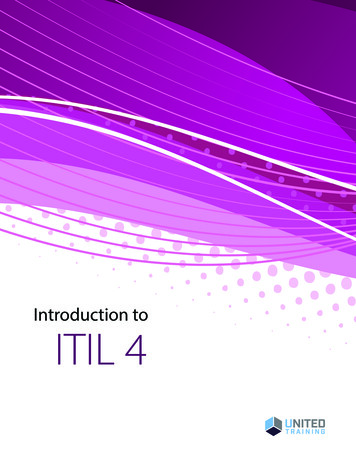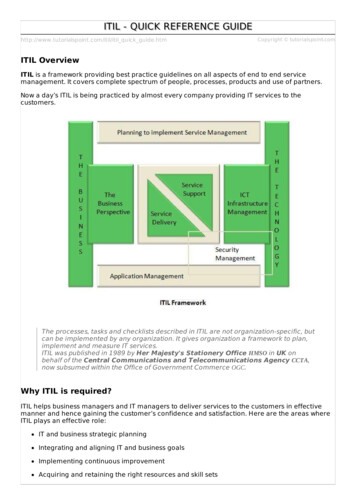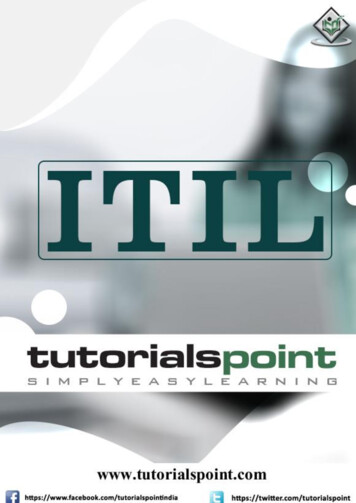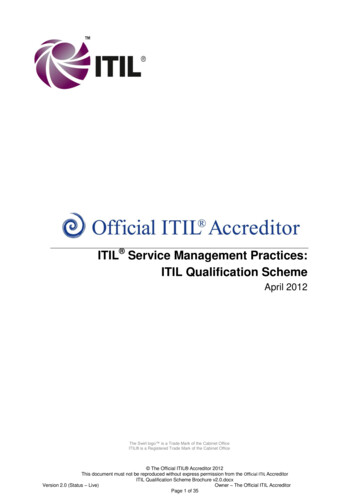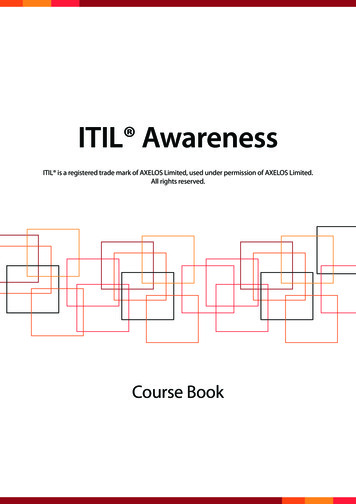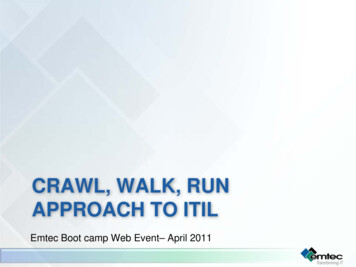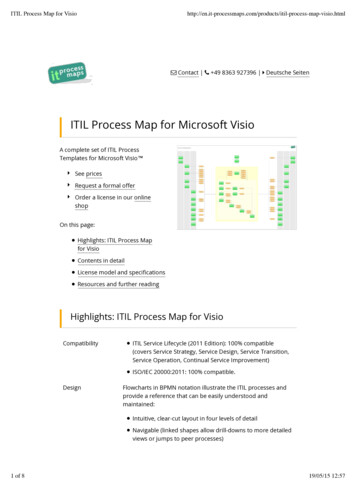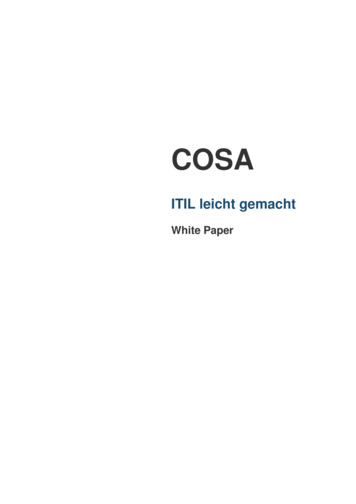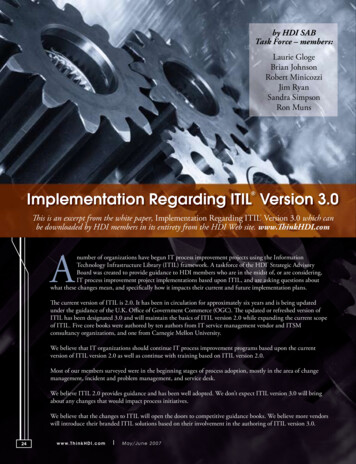
Transcription
by HDI SABTask Force – members:Laurie GlogeBrian JohnsonRobert MinicozziJim RyanSandra SimpsonRon MunsImplementation Regarding ITIL Version 3.0This is an excerpt from the white paper, Implementation Regarding ITIL Version 3.0 which canbe downloaded by HDI members in its entirety from the HDI Web site. www.ThinkHDI.comAnumber of organizations have begun IT process improvement projects using the InformationTechnology Infrastructure Library (ITIL) framework. A taskforce of the HDI Strategic AdvisoryBoard was created to provide guidance to HDI members who are in the midst of, or are considering,IT process improvement project implementations based upon ITIL, and are asking questions aboutwhat these changes mean, and specifically how it impacts their current and future implementation plans.The current version of ITIL is 2.0. It has been in circulation for approximately six years and is being updatedunder the guidance of the U.K. Office of Government Commerce (OGC). The updated or refreshed version ofITIL has been designated 3.0 and will maintain the basics of ITIL version 2.0 while expanding the current scopeof ITIL. Five core books were authored by ten authors from IT service management vendor and ITSMconsultancy organizations, and one from Carnegie Mellon University.We believe that IT organizations should continue IT process improvement programs based upon the currentversion of ITIL version 2.0 as well as continue with training based on ITIL version 2.0.Most of our members surveyed were in the beginning stages of process adoption, mostly in the area of changemanagement, incident and problem management, and service desk.We believe ITIL 2.0 provides guidance and has been well adopted. We don’t expect ITIL version 3.0 will bringabout any changes that would impact process initiatives.We believe that the changes to ITIL will open the doors to competitive guidance books. We believe more vendorswill introduce their branded ITIL solutions based on their involvement in the authoring of ITIL version 3.0.24w w w. T h i n k H D I . c o mIMay/June 2007
The principles of IT service management will continue toremain the same with very few visible changes over the nexttwo years. Market acceptance will dictate the availability ofITIL version 3.0 books.Multiple versions and the potential proliferation ofproprietary vendor offerings will create confusion andillustrate a need for governance. This will create somepolitical tension amongst the vendor community andcommunities like the IT Service Management forum, ourown HDI community, and others who are dependent onvendors as partners.While it is a risk that ITIL as we know it will perish, it is inthe best interest of vendors and key industry members whohave invested in ITIL as a standard, to maintain an industryaccepted practice. As such, expect the practice of IT servicemanagement to remain the same. Adoption rates will notincrease because of new material provided with the ITILversion 3.0 release, but in response to demand andacceptance of new business practices.Scope and ApproachAs part of our research, ITIL version 3.0 authors wereinterviewed and were reluctant to candidly share detailsabout the project or content of the ITIL version 3.0 booksfor both professional and statutory reasons—non-disclosureagreements. So, the team shifted focus and insteadinterviewed a sampling of key stakeholders involved orimpacted by the ITIL version 3.0 release and reviewed theliterature published by the OGC and others. Individualswere interviewed and documents were reviewed representingplans and decisions from the following organizations:EXIN and BCS (ISEB)—these are the two examinationbodies located in the Netherlands and the UKrespectively that for the last several years hadresponsibility for certifying individuals and trainers/training organizations/materials for the OGC on ITILversion 2.0. Recently rights to do similar certificationsfor ITIL version 3.0 were granted.Office of Government Commerce (OGC) UKgovernment body that owns the ITIL materials.The Stationery Office (TSO), a private UK companyand official publisher of ITIL books.Van Haren Publishing, global publisher of ITSM booksand ITIL related materials.itSMF board members.S u p p o r t Wo r l dITPreneurs—leading provider of Web-basedITIL training.APM Group, a private UK company with the licensefrom the OGC to manage individual certificationprograms for ITIL and to certify trainers/trainingorganizations/training materials.FindingsITIL Version 3.0 and changes from ITIL Version 2.0It has been difficult to get specific information as to whatwill be included in ITIL version 3.0 as the authors have allbeen required to sign non-disclosure agreements. However,our research has produced some general details that areprovided below.Facts and Information1. The new ITIL version 3.0 books begin with whatis being called “Core Guidance.”* This consists of fivevolumes of best practice guidance that follow servicemanagement, cradle-to grave life stages.The Core books:a) Service Strategy (SS)—A business and IT alignmentfocused view of ITIL that encompasses the vision andvalue of service management practice. This publicationrests at the center of the companion process elements thatfollow the stages in the life of service management. Itbrings the business focus into view in the service lifecycle stages as the genesis of understanding businessvision and value, and the enabling role IT services play.The publication should enable the reader to plan properlyfor implementing IT service management practices thatare tied to business needs, and to establish a structure fora new service and existing services that is aligned withITIL service management principles.b) Service Design (SD)—This publication providesguidance on the production and maintenance of ITprocesses, policies, architectures, and documents for thedesign of appropriate and innovative IT infrastructureservices, solutions, and processes to meet current andfuture agreed business requirements.c) Service Transition (ST)—This publication providesguidance and process activities for the transition ofservices into the business environment. It focuses on thebroader long-term change management role and releasepractices to consider risks, benefits, delivery mechanisms,and the ease of ongoing operations of services.KEEPING THE IT SUPPORT COMMUNIT Y CONNECTED25
d) Service Operation (SO)—This publication focuses ondelivery and control process activities to achieve a desiredsteady state of managing services on a day-to-day basis.The familiar control points of the former Service Supportand Service Delivery processes from the current versionof ITIL will form a major part of this volume.e) Continuous Service Improvement (CSI)—ITIL hashistorically promoted the need for service providers toachieve not only consistent, repeatable process activitiesto demonstrate service quality, but also to look forimprovements as part of service quality. This publicationwill focus on the process elements involved in identifyingand introducing service management improvements andissues dealing with service retirement.2. I TIL version 3.0 will contain the following threecomponents:** The “Core” component, as mentioned earlier, has fivebooks covering the lifecycle of IT services from businessneed to service optimization and subsumes virtually theentirety of the current Service Support and ServiceDelivery content.The “Complementary” component includes specificcontent targeting particular situations, industries, andenvironments. The Complementary component willchange as required, perhaps annually or quarterly.The “Web” component provides a dynamic resourcefor commonly needed and topical materials, such asprocess maps, definitions, templates, business cases,and case studies.3. The processes defined in ITIL version 2.0 are carriedover to version 3.0. The ITIL Refresh News, 1st Edition,Autumn 2006 states clearly that, “Every title in thecurrent ITIL Library has been reviewed and decisionsmade about the content that needs to be brought forwardto ITIL version 3.0. We know that much of the currentITIL Library is still in use, relevant, and valuable forsustaining progress in global adoptions of ITIL-basedIT service management. The ITIL you use today willstill be part of version 3.0 tomorrow and go forwardwith your ITSM practices.”4. A fter several scheduling slippages, ITIL version 3.0is scheduled for publication in spring 2007. As ofthis writing, the expected release of the new booksis May 2007.5. E ach of the five books in version 3.0 is contracted todifferent vendor organizations (Accenture, CarnegieMellon University, ConnectSphere, Guillemot Rock,Hewlett Packard, and Pink Elephant). Each book hastwo individuals designated as authors.26w w w. T h i n k H D I . c o mIMay/June 2007Observations1. Books have been written by a limited number ofauthors, many of whom are vendors. This means that theperspective could be based on a vendor point of view. InITIL version 2.0, a large circle of authors was employed,including practitioners, to at least provide a more openindustry framework. Vendors who bid to be authors andwere not selected may be hesitant to follow the work oftheir competitors. This could have a negative effect on theability to maintain an open framework. The good news isthat ITIL concepts are based on a set of common practiceswhich are not likely to change with a new brand. Expectto see vendor specific offerings with vendor specificbrands, which will be based on the same concepts.2. We have been informed that the total number of pagesin the five new books is approximately 2,000. Becauseof the amount of the content and the lack of time (twoor three weeks) for industry review, we are concernedthat adequate input may not be obtainable given timeconstraints. Again, this has a negative effect onmaintaining the spirit of best practices built by anopen community. Expect to see some continuity issuesin writing style and flow between various books.3. The apparent scope expansion includes operationsguidance for areas to IT services that have significantlylarge bodies of knowledge related to best practicesand were previously outside of the scope of ITIL version2.0. To adequately cover all areas of IT operations is anextremely large scope expansion for material that alreadyexists elsewhere.4. The official position from the OGC is that all ITILversion 2.0 certifications will remain valid. Suchcertifications cannot imply knowledge of the additionalscope areas covered by ITIL version 3.0. We would expectthat the two certifications will be viewed and valueddifferently causing confusion in the IT population.5. M entors and reviewers of the books were not givenaccess to the other books; they only had access totheir own specific content. This made it difficult todo a proper review. As the structure of the books waschanged, it was impossible to know if content wasmissing because it was in one of the other books orif it was just missing. In addition, with no one entityreviewing all the information there is the potentialof an inconsistent flow for the books.6. The price of the ITIL version 3.0 books will beUS 170 each or US 600 ( 85 each or 299) for theset of five books. The OGC has indicated “ we won’tcontinue to support both versions. Version 3.0 includesall version 2.0 processes with more guidance on HOWto do it.” Thus, those wishing to stay current will berequired to buy the new set. We predict that ITIL
version 2.0 books will remain in circulation untilquality assurance issues, training and certificationissues, etc. are resolved. That will likely happen overthe next two year period, but of course cannotbe guaranteed.7. When we asked Alan Nance and Abbey Wiltseof ITpreneurs, “ITIL support technology is stillnot able to support ITIL version 2.0 end-to-end,so what do you feel will be the major impact onITIL support technology with the introduction ofITIL version 3.0? Will organizations be faced withreturning to manual solutions until the technologycatches up?” They responded: “Actually, we predictan increasing disconnect between what the vendorsare offering in regards to technology solutions versusthe reality of the ITIL standards lifecycle. We feel thatthe vendors are going to out-drive the ITIL standard inthe near future.” This means that technology solutionsmay drive many service improvements making serviceimprovement initiatives appear more like systemsimplementations. The danger in this is losing focuson process goals and becoming more reliant onvendor solutions.You can see all of the findings and observations in the HDIwhite paper located on the HDI Web site.2 w w w. T h i n k H D I . c o mIMay/June 2007HDI members, view a webinar regarding ITIL version 3.0implementation featuring Ron Muns, HDI founder and CEO,and Brian Johnson, ITIL Expert. Ron and Brian will help youanswer the following questions:Should IT organizations continue or wait on processimprovement programs based on ITIL?Should you wait on attending ITIL based traininguntil the version 3.0 path is better known?Should IT organizations wait to build new processes basedupon ITIL version 3.0 process frameworks?How diff erent will ITIL version 3.0 be from ITIL 2.0?* ITIL Refresh: Scope and development plan, Office of Government Commerce (OGC),June 2006 URL: http://www.itil.co.uk/scope web.pdf retrieved February 1, 2007.** ITIL Version 3.0-What It Means to You, Hank Marquis, Global KnowledgeTraining, LLC, 2006, p. 4-5, Retrieved: February 2, 2007, URL: perpdf/WP ITILv3.pdf.Visit the SPIN section of the HDI Web site to view the webinar.www.ThinkHDI.com/SPIN
24 www.ThinkHDI.com I May/June 2007 by HDI SAB Task Force - members: Laurie Gloge Brian Johnson Robert Minicozzi Jim Ryan Sandra Simpson Ron Muns Implementation Regarding ITIL Version 3.0 Th is is an excerpt from the white paper, Implementation Regarding ITIL Version 3.0 which can be downloaded by HDI members in its entirety from the HDI Web site.


